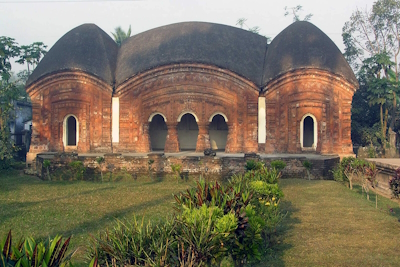Mughal and Colonial Temples of Bangladesh

Mughal and Colonial Temples of Bangladesh is part of the Tentative list of Bangladesh in order to qualify for inclusion in the World Heritage List.
The Mughal and Colonial Temples of Bangladesh are 29 Hindu and Buddhist monuments. They were inspired by the Kalinga style of temple architecture and built of brick or stone with terracotta plaques. Many of the included temples are living religious monuments.
Map of Mughal and Colonial Temples of Bangladesh
Load mapThe coordinates shown for all tentative sites were produced as a community effort. They are not official and may change on inscription.
Community Reviews
Els Slots

In my Profile section on this website, I’ve had ‘Puthia’ for a long time as one of my proposals for a new WHS. To my surprise, several monuments in Puthia were added to the Bangladeshi Tentative List last month as part of the ‘Mughal and Colonial Temples of Bangladesh’. So let me be the first to review it.
This serial site has 29 locations, of which I visited about nine during my Bangladesh trip in late December 2006 / early January 2007: one in Kantanagar and the others in Puthia (although I did not note down all their names, I've probably seen all in the cluster there). The proposal considers Hindu and Buddhist monuments that were built during the Mughal period in the 16th-19th centuries.
The Hindu temple in Kantanagar (Kantajee Temple, top left and top right photo) lies just outside Dinajpur and can be visited on foot from there. First you walk across a long, springy bamboo bridge (only to be used outside the rainy season). Then through a village with mud huts and a remarkable amount of cattle around the houses: cows, goats, oxen, chickens. And a wealth of crops: potatoes, peppers, and bananas. You can also see the production of jute here, made from flowering plants, which was once Bangladesh's largest export product but has now been supplanted worldwide by plastic.
Arriving at the temple, you first have to go through a gate, and then suddenly there is a beautiful, brick-red Hindu temple. It seems almost too big for this courtyard, and certainly too delicate. All those small images moulded and carved in terracotta seemed very fragile to me. The temple is covered from top to bottom with a narrative showing both fragments of daily life and religious images. It dates from 1722 and is still completely preserved and in use.
I added my name and admiring comments in the guestbook. I counted about one visitor per day: this region is relatively popular with the Japanese. Browsing back I also came across the name of ‘our’ Solivagant, who had given me the idea of organizing a trip to Bangladesh in the first place.
A few days later, on January 1, the Bangladeshi celebrated Eid ul-Adha, the festival of sacrifice. Parts of the town of Rahshahi's streets had been closed off to serve as an open-air mosque with rows of men sitting in the street. A little further on we saw the blood flowing abundantly along the road from the ritual slaughter of goats and cows. On this Islamic holiday, we went to the Hindu town of Puthia. It houses the largest number of Hindu structures in Bangladesh. And it's incredibly atmospheric. As soon as I entered, my mouth fell open in amazement and admiration of pure beauty. The town (it used to be an estate) is an ensemble of ponds, palaces, and temples.
The car dropped my guide and me off at the Maidan, the open lawn between two of the city's most important monuments. One is the dilapidated Maharani's palace, now used by the university. The other is a large white Shiva temple to a North Indian design from 1823. We continued on foot through this quiet town to the great Govinda temple, dedicated to the Hindu god Krishna. This is also from the 19th century but has a completely different design, with turrets.
We walked on along the banks of a large pond to the other side, where we visited the Bara Anhik Mandir. This has a stone roof in the shape of the traditional bamboo roofs of the Bengal mud huts. It has terracotta decorations too. The year before, a large piece of its terracotta façade was stolen. These temples do have guards keeping an eye on them, but this is not enough against real theft.
In all, it was remarkable to find these art treasures here (just like in Kantanagar) in the Bengali countryside. Their state of conservation and management clearly need attention, so I hope this Tentative listing and a possible future nomination may bring it.
Site Info
- Full Name
- Mughal and Colonial Temples of Bangladesh
- Country
- Bangladesh
- Added
- 2023
- Type
- Cultural
- Categories
- Archaeological site - South (East) Asian
- Link
- By ID
Site History
2023 Added to Tentative List
Site Links
Visitors
7 Community Members have visited.